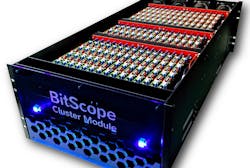Software developers who write (or want to write) software for supercomputers just got a huge holiday present: a way to test their software for bugs without having to use a supercomputer. It’s an affordable, scalable device consisting of thousands of inexpensive Raspberry Pi nodes and serves as a powerful high-performance-computing testbed for system-software developers, researchers, and others who lack machine time on the world’s fastest supercomputers.
“It’s not like you can keep a petascale machine around for R&D work in scalable systems software,” says Gary Grider, leader of the High Performance Computing Division at Los Alamos National Laboratory, home of the Trinity supercomputer. “The Raspberry Pi modules let developers figure out how to write this software and get it to work reliably without having a dedicated testbed of the same size, which would cost a quarter-billion dollars and use 25 megawatts of electricity.”
Grider developed the device to provide the systems software community with an inexpensive testbed similar in scale to the largest supercomputers being deployed. Designed and built by BitScope and distributed by SICORP, the Pi Cluster Modules let developers build, scale, and test software before launching it on Trinity, Crossroads, or other supercomputers.
The BitScope consists of five rack-mounted Pi Cluster Modules, each with 150 four-core nodes of Raspberry Pi ARM processor boards. They are fully integrated with network switching infrastructure. With a total of 750 CPUs or 3,000 cores working together, BitScope gives developers exclusive time on an inexpensive but highly parallelized platform for test and validation of scalable systems software.
“Having worked with Raspberry Pi for quite some time, I’ve long thought it the ideal candidate to build low-cost cloud and cluster computer tools for research and education,” says Bruce Tulloch, CEO of BitScope. “When SICORP approached us with Gary’s plans, we jumped at the opportunity to prove the concept.”
The BitScope Pi Cluster Modules create an affordable, scalable, highly parallel testbed for developing software for high-performance-computers. It is comprised of five rack-mounted BitScope Pi Cluster Modules containing 3,000 cores using Raspberry Pi ARM processor boards with a network switching infrastructure. (Credit: Bitscope)
Raspberry Pi is an inexpensive, credit-card sized computer that can be connected to a keyboard and TV to do just about anything a typical desktop computer can do. It was developed by the Raspberry Pi Foundation in the United Kingdom to help spread computing in education and in developing countries. The price for a basic model starts at about $25 and consumes only a handful of watts of power.
Beyond supercomputer-software development, additional applications for the Pi Cluster Modules include better simulation of large-scale sensor networks with flexible I/O to connect actual sensors; HPC network topology research to improve production performance; and the Internet of Things (IoT).
Looking around for a solution to the challenges facing supercomputer software developers, Grider suddenly realized Raspberry Pi was an inexpensive computer using two to three watts that you could use to build a several-thousand-node system large enough to provide a low-cost, low-power testbed to enable this R&D. But he could not find a suitable densely-packaged Raspberry Pi tool on the market.
“It was just people building clusters with Tinker Toys and Legos,” says Grider, a widely respected innovator in the supercomputing world. So he turned to SICORP of Albuquerque, to collaborate on a solution. Then they jointly worked with BitScope of Australia to develop easily scaled rack-mounted units.


